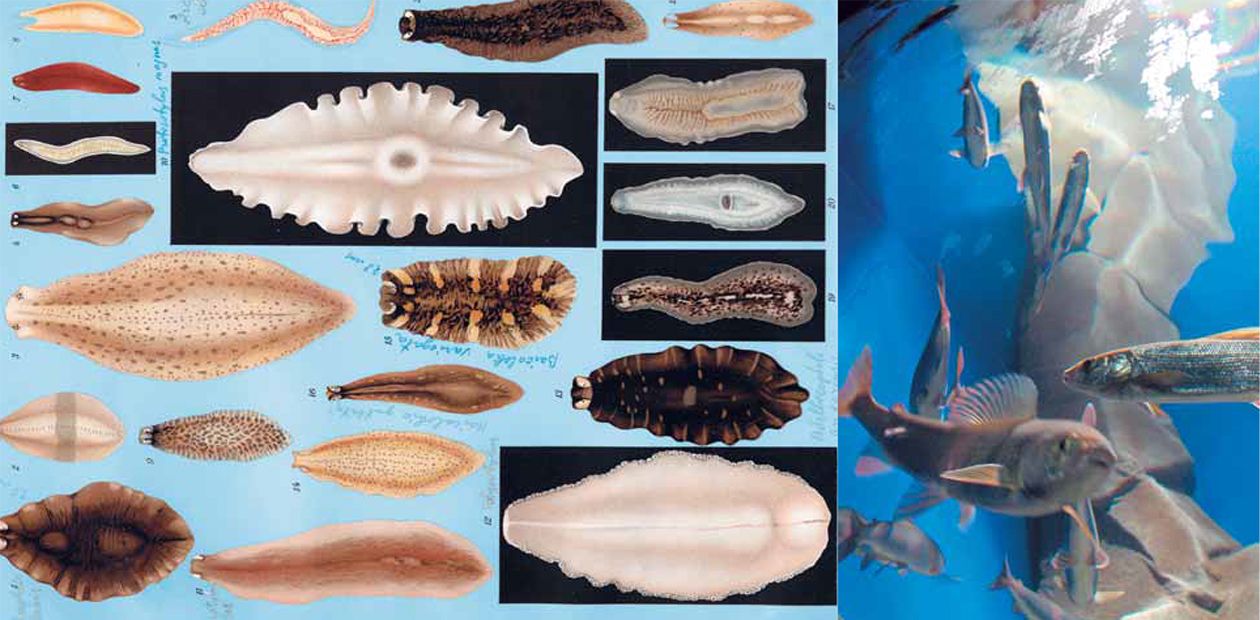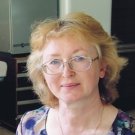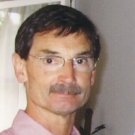Invisible Network
No other sphere of activity but science confronts so much the succession of the past and the present. Any break in the continuity inevitably means irreplaceability and loss of some branches of science. Conversely, collections have always been an indispensable feature of scientific activity. The “Project of Regulations on Foundation of the Academy of Sciences and Arts” that was approved by the Russian Senate in 1724, emphasized the “profit gained from discussion of the results by the representatives of various disciplines”. These principles as well as the others initiated by Peter I provided a basis for the present Charter of the Russian Academy of Sciences.
Using the example of investigations of diatoms of the genus Aulacoseira, we hope to demonstrate the existence of an invisible network of relationships in science: forwards, and indeed backwards, through time and horizontally as it were, between contemporaneous researchers, events, and phenomena
Tiny Staff
Diatoms are unicellular aquatic plants that produce siliceous cell walls of extraordinary beauty. However, it is possible to see the peculiarities of the cell wall structure only with the help of light, scanning, and transmission microscopes.
According to different estimations of researchers, the share of these imperceptible workers accounts for between 20 and 40 % of the total primary organic production on the Earth including all terrestrial plants! Because cell walls of diatoms may be preserved in the sediments of lakes, seas, and oceans over geological time scales, we can trace historical developments of aquatic plant communities.
Different species of these algae demand different living conditions and, thus the diatom community is very much an indication of both environmental and climatic changes. Studies of different diatoms in bottom sediment cores have provided much valuable evidence of, for example, such phenomena as the influence of industrialization on the acidification of European lakes or the changing pattern of deep currents in the oceans.
Diatoms have many uses in industry. The age of sediments and oil deposits are estimated according to the results of analyses on the distribution of diatoms in boreholes. Diatomites (sedimentary rocks comprising cell walls of dead diatoms) are mined or quarried for fine abrasives, filters for the wine and brewing trade, and building material among many other uses.
Because of their small size, their study has very much run parallel with the development of microscopy. Since the late 1700s diatoms have been prepared for the light microscope serving as an original standard for checking the quality of optical lenses. As soon as it was revealed that permanent preparations could be made of the cell wall, which could be stored indefinitely, diatom collections were created. They became the foundation stones of diatom systematics — the naming of the different species and their organization into hierarchical groupings.
Since the 1960s the electron microscope has been used more and more, discovering new details, new taxa. In the last 10 years or so, attention has turned to molecular techniques and to some extent away from the classical morphological studies.
Germans On Lake Baikal
Scientists of various specialties and nationalities were involved in one way or another in investigations of Baikal diatoms, and without doubt, German researchers bore the palm.
The first German scientist to visit the Lake Baikal area was Daniil Gotlieb Messerschmidt (1685—1735) who was invited by no less than Peter the Great, before the foundation of the Academy of Sciences in Russia, and from 1720 till 1727, he traveled around Siberia. Messerschmidt collected information on history, ethnography, geography, and economics, as well as wonderful collections of plants and animals including the bones of mammoths. Most of his collections, unfortunately, were lost during the shipwreck and the fire in Petersburg.
Having discovered that the Russian government invited scientists to explore new lands, Johan Gotlieb Georgi (1729—1802), another gifted German scientist and tireless traveler, asked to be included in one of the expedition groups. Together with a team of Peter Simon Pallas, he spent two years in an expedition on Lake Baikal (1772—1774). During that short period of time Ivan Ivanovich (Russian colleagues gave Georgi this name) compiled a detailed map of Lake Baikal, recorded the conditions of the environment of that period in detail, found and described many hitherto unknown organisms inhabiting Lake Baikal including Baikal fish omul — Coregonus autumnalis migratorius Georgi. Georgi sent samples of sediments to St. Petersburg and other cities. Some of the material he had collected from the Barguzin River valley was sent to Berlin and Klaprot’s collection of minerals and later to Ehrenberg’s.
Martin Henry Klaprot (1743—1817) was a famous chemist and mineralogist. With a collection of different natural minerals and rocks at the Museum of Natural History in Berlin, Klaprot discovered 4 new elements including uranium in 1789. It is of great importance for us that with the help of uranium isotope analysis carried out since the late 1980s, the time of appearance of Aulacoseira baicalensis, which is the dominant host of the Baikal modern phytoplankton was established in bottom sediments of Lake Baikal. In honor of this dominant species, the years of its active growth are known as Melosira years (by the previous name of the genus).
Christian Gotfried Ehrenberg (1795—1876) was one of the first and the foremost microscopists of his day. Many travelers and researchers, including the outstanding Charles Darwin, sent him their samples of soil, dust, volcanic ash, and marine and freshwater organisms collected in different parts of the world. For Ehrenberg diatoms were the main and favorite objects of investigation. From 1838 till 1854, he discovered 35 genera of diatoms and 4 genera of other unicellular algae; altogether he described several thousand species.
Diatom Triumvirate
While traveling, Ehrenberg always took with him a microscope and some paper for drawing. In daytime he collected samples, and at night he made drawings of the algae found in the samples. There are hundreds of his original drawings kept in the collection in Berlin. Ehrenberg and later Friedrich Kuetzing (1807—1893) and Otto Mueller (1837—1917) made up a triumvirate that heralded an exceptionally strong tradition of diatom study in Germany, which continues today.
Although the resolution of his microscope was poor and mica of low transparency was used for preparations, Ehrenberg was able to distinguish between the finest organisms, and following the tradition of Linneaus, gave Latin binomials to them, the genus name followed by the specific name.
Many of the small, colored algae were placed in the genus Gailonella. This genus name was later reserved for a bacterium. The diatoms were then removed to other genera by Kuetzing. For example, he removed some diatoms forming filamentous colonies to the genus Melosira (a latinized Greek name meaning ‘chain of beads’). This move from one genus to another illustrates a fundamental principle of systematics: if a species other than that on which the genus is based, is considered to be sufficiently different from the type species, then it should be removed from that genus to another (new or already established) one.
In 1848, for example, an Englishman George Thwaites (1812—1882) thought that some of the freshwater species of Melosira differed significantly from the primarily brackish/marine type species — Melosira nummuloides — and that they should be removed to a new genus Aulacoseira. This proposal was largely ignored, however, and it was not until 130 years later that Reimer Simonsen, working in Bremerhaven at that time and living now in Bremen, published new combinations for 59 species and intraspecific taxa. At that time Simonsen was a curator of one of the largest collections of diatoms in the world consisting of about 65,000 slides of their cell walls collected by Friedrich Hustedt (1886—1968), the best-known diatomist of his day.
Everything Is Over — Everything Remains
By the middle of the 20th century the number of recorded diatom taxa had exploded dramatically. However, the principles of diatom systematics were unchanged and collections remained their central basis. It was appreciated that without a voucher specimen on which a name was based, the names used by biologists, ecologists, etc., could have doubtful credibility.
It is fortunate for diatomists that their cell walls can be permanently preserved for a long time and as a result, the main part of collections has been passed from generation to generation. It means that we are always able to go back to the original material to check identities.
Inevitably the early descriptions of diatoms were limited by performance capabilities of microscopes. Now we are able not only to obtain much better light microscope images but also to use electron microscopy for studying their fine structure. Further, we are able to check the phylogenetic relationships, and therefore the taxonomy of our taxa with other techniques such as molecular biology.
A. P. Skabichevsky (1904—1991), famous Russian algologist, was born in the St.-Petersburg province to a teacher’s family. Upon graduating from the Pedagogical Department of Irkutsk University, between 1927 and 1938 he carried out scientific research on Lake Baikal. Among 119 Skabichevsky’s publications on systematization, ecology, and evolution of algae, more than 40 were devoted to Lake Baikal and Baikal Region species. He discovered and described three new genera and over 40 species and intraspecific taxa of algae of Siberian water bodies.The Symposium will consider recent achievements in studying living diatom cell using nontraditional lines of discussions.
It is planned to debate a wide spectrum of questions concerning the mechanisms of silica transfer and diatom shell formation, the life cycle and reproduction of diatom cells, their functioning in oceans and great lakes.
Living diatom cell will be examined from different viewpoints, for example, as a cellular structure with a siliceous wall, a model organism for biodiversity studies, and a sample for structural and molecular engineering and nanotechnology. Diatoms genetics and physiology aspects, as well as excellent adaptability of diatoms will be discussed.
A Lake Baikal boat tour will be provided for sampling of diatoms during several halts in picturesque locations. Excursions to the Limnological Station at Bolshiye Koty, the Museum of Lake Baikal in Listvyanka, and the Museum of Wooden Architecture will be arranged.
To return to Aulacoseira, we have been able to locate the site in the Barguzin River valley where Georgi visited and sampled. Due to the INTAS project that supports the relationships among researchers of different countries, we had the chance to work together with German colleagues. We have managed to find original materials in Ehrenberg’s collection in Berlin and examined it with scanning microscopy. To our great fortune, the valves of diatoms appeared to be as well preserved as some material that we might collect today.
In 1843 when Ehrenberg described A. granulata from the soil of Newfoundland, he published also the fact of its discovery in the material from the Barguzin River. It will give us an indication of what Ehrenberg was understood by this name over 160 years ago!
This widely branched network connecting scientists of interfacing or even unrelated specialties from different countries has been extending from the 18th century to present day. Touching the preparations made with love by our colleagues centuries ago, we not only bridge the gaps in our knowledge, but also become a part of that continuous flow of scientific thought, which will connect our work with the future.
Photos of Ehrenberg’s Collection samples (Museum of Natural History, Berlin) are used in illustrations and graphic design
The authors and Editorial Board are thankful to Dr. David Lazarus, Ehrenberg’s Collection curator (Museum of Natural History, Berlin), for his help in preparing illustrative materials for the paper
In the next issue
Deep-water drilling on Lake Baikal yielded the first sample of Baikal gas hydrates, ice-like mixtures of gases and water. Each volume of hydrates can contain up to 150—180 volumes of gas! In nature, gas hydrates are formed in the permafrost regions or in the marine environments. Baikal is the only place on Earth where gas hydrates occur in freshwater sediments.
Methane contained in gas hydrates can play a significant role in global climatic processes, since it is more than 20 times more efficient in creating ‘greenhouse effect’ than carbon dioxide. Destabilization of gas hydrates can lead to such disasters as landslips, tsunami, or flooding of coastal areas. On the other hand, gas hydrates are a potential fuel resource, an ‘alternative’ energy source for the future generations since the reserves of methane in hydrate form are huge. The history of discoveries of gas seepage and gas hydrates in Baikal, as well as recent studies of unique freshwater gas hydrate formations, will be reported by Jean Klerkx in the paper “Gas Hydrates in Freshwater Ocean”.
In the next issue
A distinctive feature of Lake Baikal is very thick bottom sediments, which in southern and central basins of the lake reach 8 km. Sediments of Lake Baikal contain unique continuous record of climate changes in the Eurasian continent over the last 30 million years. A key to deciphering paleoclimatic records is siliceous frustules of diatoms. Unicellular diatoms make up a considerable part of phytoplankton, up to 20—40 % of all primary organic production, including land plants! Since cellular walls of diatoms are well preserved in bottom sediments of lakes, seas and oceans, they can be used for reconstructing the past changes in the environment conditions.
The idea of studying the past of the Northern hemisphere on the basis of sedimentary records underlay the international project “Studies of Environment and Climate Changes in Central Asia on the Basis of Examination of Lake Baikal Sediments,” which was prepared and implemented with active participation of the staff of Limnological Institute and the Institute of Geochemistry of the Siberian Branch of the Russian Academy of Sciences. Considerable financial support was provided by foreign research institutions. NEDRA Drilling Enterprise designed and produced an original drilling complex. Since 1997 five well clusters have been drilled at the depths varying from 100 to 670 meters. Analysis of the contents of the remains of different diatom species obtained from the cores made it possible to distinguish several thousand-year-long climatic cycles with regard to the Earth’s solar orbit. In the next issue, Academician Mikhail Kuzmin, one of the initiators and participants of the project, Director of the Institute of Geochemistry SB RAS, will tell about the deep-water drilling exploits and scientific results ‘extracted’ from unique core samples.
















